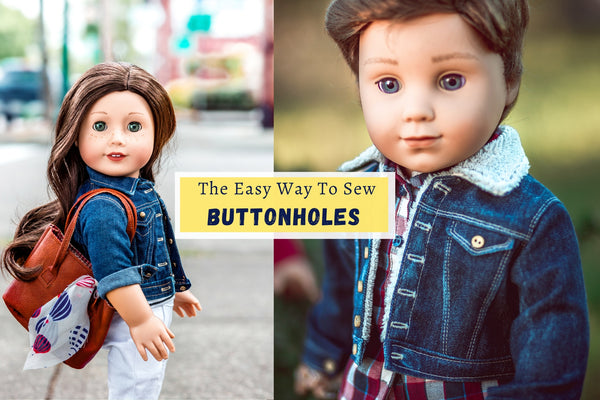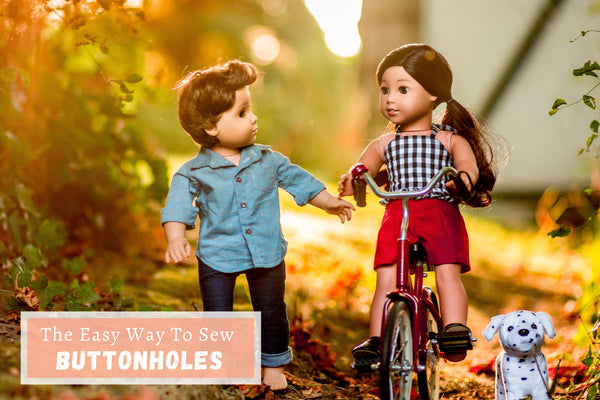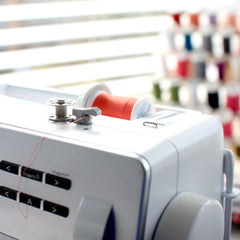
The Basting Stitch is a versatile sewing method with lots of uses. While it may seem like a simple and insignificant step, the basting stitch can offer many surprising benefits. This article will explore the top 36 reasons to use a basting stitch in your sewing projects, providing valuable insights and tips to enhance your craft.
The 36 Reasons To Use A Basting Stitch
#1 Preparing for Gathering
One of the primary purposes of a basting stitch is to prepare the fabric for gathering. Before sewing, use a basting stitch to create even and controlled gathers, ensuring a professional and polished look.
#2 Testing Fit and Adjustments

A basting stitch allows you to test the fit of a garment before committing to a permanent seam. This is especially useful when sewing for dolls with unique body shapes and sizes, as it allows for easy adjustments without seam ripping.
#3 Securing Delicate Fabrics

When working with delicate fabrics such as silk or chiffon, a basting stitch can provide temporary stability, preventing the fabric from shifting or stretching during the sewing process.
#4 Easier Seam Matching

Basting the seams together before sewing allows you to easily match the edges and ensure a precise and seamless finish. This is particularly helpful when working with intricate patterns or small-scale projects. Learn how to work with striped fabrics in this in-depth tutorial.
#5 Facilitating Sleeve Attachment

Sewing sleeves can be challenging, especially when dealing with small-scale garments. A basting stitch along the sleeve cap seam allows easier attachment, ensuring a smooth and professional finish.
#6 Creating Temporary Hems

A basting stitch can create a temporary hem when determining the ideal length for a doll's dress or skirt. This allows you to make adjustments without permanently altering the garment.
#7 Tacking Down Trims and Embellishments

If you add trims or embellishments, a basting stitch can temporarily secure them. This allows you to experiment with different placements and easily remove or adjust the trims.
#8 Easier Zipper Installation

When sewing with zippers, a basting stitch can temporarily hold the zipper in place, making the installation process much easier and more precise.
#9 Creating Temporary Darts
Darts are essential for achieving a proper fit. Using a basting stitch to create temporary darts, you can easily adjust and fine-tune the fit before sewing the permanent seams. Looking for a pattern with darts? Try the Winner's Circle pattern from Karen Lorraine Designs.
#10 Preventing Fabric Shifting
When working with slippery or stretchy fabrics, a basting stitch can help prevent the fabric from shifting or stretching during the sewing process, ensuring more accurate and precise seams. Learn more about Sewing With Specialty Fabrics in Sewing With Cinnamon & Friends!
#11 Easier Lining Attachment
When sewing with linings, a basting stitch can temporarily attach the lining to the main fabric, making the assembly process easier and more efficient.
#12 Creating Temporary Pleats
Pleats are a popular design element. Using a basting stitch to create temporary pleats, you can easily adjust and fine-tune the placement and size before sewing the permanent seams. See the Vintage Playsuit pattern hack.
#13 Easier Collar Attachment
Sewing collars can be challenging, especially when working with small-scale garments. A basting stitch along the collar seam allows easier attachment, ensuring a smooth and professional finish. Learn more about Sewing Tiny Collars in this Sewing With Cinnamon blog post with video, it's free to view!
#14 Facilitating Button and Buttonhole Placement
When sewing with buttons and buttonholes, a basting stitch can temporarily mark the placement of the buttons and buttonholes, making the installation process much easier and more precise.
#15 Creating Temporary Tucks
Tucks are a popular design element in fashion. Using a basting stitch to create temporary tucks, you can easily adjust and fine-tune the placement and size before sewing the permanent seams.
#16 Easier Waistband Attachment
When sewing with waistbands, a basting stitch can temporarily hold the waistband in place, making the attachment process much easier and more precise.
#17 Creating Temporary Gathers

Whether you need to secure ruffles, Waistbands, waistlines, Sleeves, skirts, bodices, or necklines, using a basting stitch, you can easily adjust and fine-tune the placement and size of the element before sewing the permanent seams.
#18 Easier Cuff Attachment
Sewing cuffs can be challenging, especially when working with small-scale garments. A basting stitch along the cuff seam allows for easier attachment, ensuring a smooth and professional finish.
#19 Facilitating Appliqué Placement
When adding appliqués, a basting stitch can temporarily hold the appliqué in place, making the placement process much easier and more precise.
#20 Creating Pockets
Pockets are a functional and stylish addition to any garment. Using a basting stitch to create temporary pockets, you can easily adjust and fine-tune the placement and size before sewing the permanent seams.
#21 Easier Bias Tape Application
Bias tape is a versatile and practical finishing technique. A basting stitch can temporarily hold the bias tape, making the application process easier and more precise.
#22 Facilitating Lining Hem Attachment
When sewing linings, a basting stitch can temporarily attach the lining hem to the main fabric, making the assembly process easier and more efficient.
#23 Creating Temporary Ruching
Ruching is a popular design element. Using a basting stitch to create temporary ruching, you can easily adjust and fine-tune the placement and size before sewing the permanent seams.
#24 Facilitating Elastic Installation
When sewing with elastic, a basting stitch can temporarily hold the elastic, making the installation process much easier and more precise.
#25 Easier Pintuck Alignment
Pintucks are a decorative and stylish feature. Using a basting stitch combined with a pintuck foot, you can easily create precise and even pintucks without the need for a double needle. The basting stitch helps to hold the fabric in place, allowing for more accurate stitching and ensuring that the pintucks are evenly spaced and aligned.
#26 Easier Hemming
Hemming is an essential step in finishing a garment. A basting stitch is ideal for creating a curved hemline. Learn all about hemming techniques in this in-depth tutorial.
#27 Facilitating Lace Attachment
When adding lace to your garment, a basting stitch can temporarily hold the lace, making the attachment process much easier and more precise.
#28 Easier Casing Attachment
When sewing with casings, a basting stitch can temporarily hold the casing, making the attachment process much easier and more precise.
#29 Facilitating Ribbon Attachment
When adding ribbon to your clothes, a basting stitch can temporarily hold the ribbon, making the attachment process much easier and more precise.
#30 Creating Temporary Pleats for Collars
Collars are tricky to get installed correctly. Using a basting stitch to create temporary pleats, you can easily adjust and fine-tune the placement and size of the collars before sewing the permanent seams.
#31 Easier Cuff Hemming
Hemming cuffs can be challenging, especially when working with small-scale garments. A basting stitch can create a temporary hem, allowing you to adjust the length and ensure a professional finish.
#32 Easier Piping Hemming
Hemming piping can be challenging, especially when working with small-scale garments. A basting stitch can create a temporary hem, allowing you to adjust the length and ensure a professional finish.
#33 Facilitating Piping Installation
Piping is a great way to add a decorative touch. A basting stitch can temporarily hold the piping, making the installation process easier and more precise.
#34 Facilitating Lace Hemming
When hemming with lace, a basting stitch can create a temporary hem, allowing you to adjust the length and ensure a professional finish.
#35 Facilitating Zipper Hemming
Hemming zippers can be challenging, especially when working with small-scale garments. A basting stitch can create a temporary hem, allowing you to adjust the length and ensure a professional finish.
#36 Creating Temporary Gathers for Bodice Insets
Bodice insets are an important part of design. Using a basting stitch to create temporary gathers, you can easily adjust and fine-tune the placement and size of the bodice insets before sewing the permanent seams.
Conclusion
In conclusion, the basting stitch is a versatile and essential technique in sewing. From preparing for gathering to facilitating lace attachment, the basting stitch offers many surprising benefits that can enhance the quality and precision of your craft. By incorporating these uses for a basting stitch into your sewing projects, you can take your sewing to the next level and achieve professional and polished results. Keep Learning - check out our tutorial on How To Do Four Basic Hand Stitches.

 Do you avoid designs with functional buttons and buttonholes because it is just too likley that your project will be destroyed? Fear no more, this tutorial will show you how to create dainty thread loop button closures!
Do you avoid designs with functional buttons and buttonholes because it is just too likley that your project will be destroyed? Fear no more, this tutorial will show you how to create dainty thread loop button closures! 


































































































































 HI! I'm Cinnamon, from Liberty Jane Clothing. Follow along as I show you how to use a sewing machine. Got sewing questions? Ask them in the comments, I'll try to answer them in upcomming videos :)
HI! I'm Cinnamon, from Liberty Jane Clothing. Follow along as I show you how to use a sewing machine. Got sewing questions? Ask them in the comments, I'll try to answer them in upcomming videos :) Follow along as Melinda from Liberty Jane shows you how to cut out the trendy t-shirt pattern.
Follow along as Melinda from Liberty Jane shows you how to cut out the trendy t-shirt pattern. Are you new to sewing? Do you need to learn the basics? Do you want to see what is being taught with clear color photo's? This new book, written by Cinnamon Miles of Liberty Jane Clothing, may be the perfect thing to guide you on your journey to learn to sew!
Are you new to sewing? Do you need to learn the basics? Do you want to see what is being taught with clear color photo's? This new book, written by Cinnamon Miles of Liberty Jane Clothing, may be the perfect thing to guide you on your journey to learn to sew!

